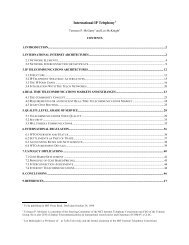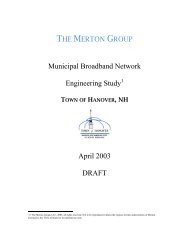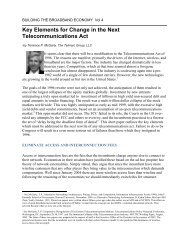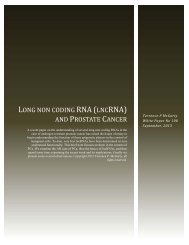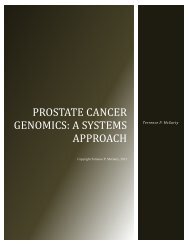progressivism, individualism, and the public ... - Telmarc Group
progressivism, individualism, and the public ... - Telmarc Group
progressivism, individualism, and the public ... - Telmarc Group
Create successful ePaper yourself
Turn your PDF publications into a flip-book with our unique Google optimized e-Paper software.
The <strong>Telmarc</strong> <strong>Group</strong><br />
PROGRESSIVISM, INDIVIDUALISM, AND THE PUBLIC<br />
INTELLECTUAL<br />
writing on his dissent is quite telling <strong>and</strong> it should have gotten a bit more coverage by <strong>the</strong><br />
author. Br<strong>and</strong>eis states in his dissent:<br />
"Of all <strong>the</strong> rights of <strong>the</strong> citizen, few are of greater importance or more essential to his<br />
peace <strong>and</strong> happiness than <strong>the</strong> right of personal security, <strong>and</strong> that involves not merely<br />
protection of his person from assault, but exemption of his private affairs, books, <strong>and</strong><br />
papers, from <strong>the</strong> inspection <strong>and</strong> scrutiny of o<strong>the</strong>rs. Without <strong>the</strong> enjoyment of this right, all<br />
o<strong>the</strong>rs would lose half <strong>the</strong>ir value."<br />
To me this needs a substantially longer discussion but <strong>the</strong> author does do it some credit.<br />
4.6.2 Style<br />
The second issue is <strong>the</strong> relationship between Br<strong>and</strong>eis <strong>and</strong> Taylor <strong>and</strong> Galbreth, both<br />
early 20th century management consultants. There is a recent article in The New Yorker<br />
by Jill Lepore, a superb piece of critical <strong>and</strong> historical analysis of Br<strong>and</strong>eis, which<br />
discusses this relationship in detail <strong>and</strong> presents many of <strong>the</strong> weaknesses in Br<strong>and</strong>eis.<br />
Lepore looks at Br<strong>and</strong>eis through <strong>the</strong> lens of <strong>the</strong> management <strong>and</strong> efficiency consultants,<br />
in many ways <strong>the</strong> hucksters who predated <strong>the</strong> current Business Schools. She starts her<br />
article by stating:<br />
"Ordering people around, which used to be just a way to get things done, was elevated to<br />
a science in October of 1910, when Louis Br<strong>and</strong>eis, a fifty-three-year-old lawyer from<br />
Boston, held a meeting at an apartment in New York with a bunch of experts who, at<br />
Br<strong>and</strong>eis's urging, decided to call what <strong>the</strong>y were experts at "scientific management."<br />
Everyone <strong>the</strong>re--including Frank <strong>and</strong> Lillian Galbreth, best known today as <strong>the</strong> parents<br />
in "Cheaper by <strong>the</strong> Dozen"--had contracted "Tayloritis": <strong>the</strong>y were enthralled by an<br />
industrial engineer from Philadelphia named Frederick Winslow Taylor, who had been<br />
ordering people around, scientifically, for years."<br />
The essence of <strong>the</strong> tale is that Br<strong>and</strong>eis, who at <strong>the</strong> time was sitting on a regulatory body<br />
which controlled <strong>the</strong> monopoly like rates of railroads had gotten enthralled with <strong>the</strong> less<br />
than scientific work of Taylor <strong>and</strong> <strong>the</strong> Galbreth. He <strong>the</strong>n saw that railroads should employ<br />
<strong>the</strong>se new management techniques <strong>and</strong> <strong>the</strong>n lower <strong>the</strong>ir rates. Simple, except as Lepore<br />
states, <strong>the</strong> Taylor results were a fraud! Perhaps <strong>the</strong>re is a lesson here for many o<strong>the</strong>r<br />
"scientifically" based causes seeking legal justification. Br<strong>and</strong>eis was a brilliant legal<br />
scholar, however he had no expertise in <strong>the</strong> area of actually running a company. He did<br />
however underst<strong>and</strong> <strong>the</strong> "books" <strong>and</strong> "records" of a company <strong>and</strong> as such he had used this<br />
profitably in his law practice. Yet <strong>the</strong> Taylor approach assumed you looked forward <strong>and</strong><br />
not backward, that you understood <strong>the</strong> business as a living entity <strong>and</strong> not just <strong>the</strong> records<br />
of what happened. Br<strong>and</strong>eis was a lawyer at heart, as such he always looked backwards<br />
for precedent.<br />
The author of <strong>the</strong> present biography gives, in my opinion, short shrift to this issue<br />
discussed by Lepore. He covers it on pp 240-243 but his discussion misses <strong>the</strong> key point<br />
presented by Lepore. Namely that Br<strong>and</strong>ies became enamored with Taylor <strong>and</strong> Galbreth<br />
Page 100



